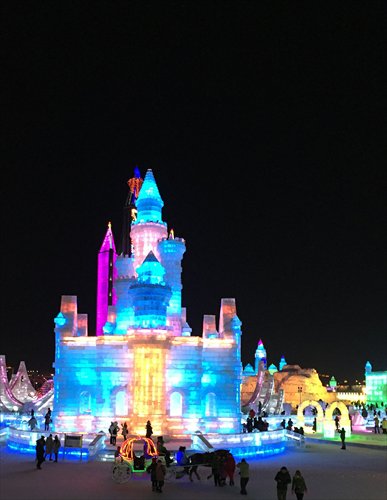

A castle made of ice at the Harbin Ice and Snow Festival, which opened in early January. Photo: Courtesy of Huang Weiwen
The veracity of the story cannot be confirmed, although it is known to historians that the Changbai Mountains was a place of sanctuary during the Qing Dynasty.
"Skiing and going to hot springs in the Changbai Mountains is great," said Huang. "But for me, the allure of the mountains is its ancient history and its mystery as depicted in The Grave Robbers' Chronicles."
Tiger tourism
Toward the south of Heilongjiang Province is Mudanjiang, an area that is home to a number of villages where film sets for The Taking of Tiger Mountain were erected. The film, adapted from a novel by Qu Bo, tells the account of a heroic People's Liberation Army captain who fights to rid the region of the plague of banditry. It has done brisk business at the Chinese box-office, and the locations used for the film have since become attractions for curious tourists.
Zhang Weidong, 29, traveled to Mudanjiang earlier this month for this very purpose.
"I saw The Taking of Tiger Mountain on the first day it came out," said Zhang. "[In Mudanjiang], I bought an artificial fur hat and asked my girlfriend if I looked like Yang Zirong [the hero in the film], but she told me I looked more like Lord Hawk, the leader of the bandit gang."
In addition to visiting the studio film lots that were used as locations in the film, Zhang also visited the Siberian Tiger Forest Park, a protected reserve in which some 800 tigers roam freely. Tourists are taken through the park in reinforced jeeps, and for their own safety, are prevented from leaving the vehicles at any point.
"The tigers were lively and quite terrifying, unlike the ones you see lazing around in cages at zoos," said Zhang.
The Taking of Tiger Mountain has seen tourism to the area boom. Dai Yu, a sales manager for online travel company Ctrip, said that searches for "Tiger Mountain" on their website soared after the film's release at the end of December.
"We've had triple the number of people signing up to visit the area compared to the same period last year," said Dai.
According to Harbin-based newspaper Life Daily, in total, more than 60,000 people visited Mudanjiang over the three-day New Year holidays, which represented a 9 percent increase in tourists to the region over the same period last year.
Zhang's only regret was that his camera stopped working due to the extreme cold in the mountains.
"Only tough guys, like bandits, can survive such harsh winters!" Zhang joked.
The home of Xiao Hong
Hulan, another small town in Heilongjiang Province, has likewise been showered with attention since the release of The Golden Era in cinemas last year. The film, which was accorded the honor of being Hong Kong's official entry for the Best Foreign Language Film at the Oscars this year, is a lovingly observed biopic of pioneering female writer Xiao Hong, who grew up in Hulan.
Li Shanshan, a junior high school teacher who lives in Harbin, has visited the town twice, both times taking the opportunity to see Xiao's childhood home.
"[The first time I visited], her old house had been left more or less undisturbed. It was quiet, small, and without much ornamentation," said Li, describing her initial trip around 10 years ago. "When I went there again, after the movie had come out, the house had been completely restored. There were a lot of visitors coming in and out."
Li said that she was pleased that the film had renewed focus on Xiao's life and work, and breathed new life into the village.
"I think Hulan is to Xiao as Shaoxing to Lu Xun or London to Dickens," said Li. She said that she hoped the film would also lead people to rediscover the folk traditions of China's northeast.
"Every time people talk about Northeast China's art and culture, they mention er ren zhuan (a folk song and dance routine known for its humor), as if it's our only art form," said Li.
Despite being a small town, Hulan is also home to a number of culturally significant sites, such as Hulan Catholic Church and the Nangang Park.
Li said that she will do what she can to contribute to the revival of interest in the township.
"I think I'm going to make my students read Xiao Hong's works," said Li.
Copyright ©1999-2018
Chinanews.com. All rights reserved.
Reproduction in whole or in part without permission is prohibited.